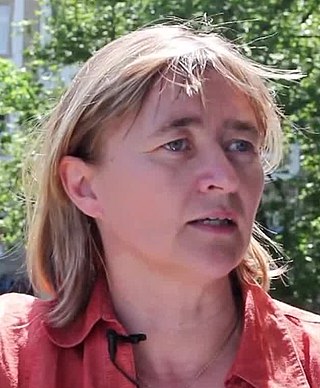Related Research Articles
Lawrence R. Rabiner is an electrical engineer working in the fields of digital signal processing and speech processing; in particular in digital signal processing for automatic speech recognition. He has worked on systems for AT&T Corporation for speech recognition.

Thomas Shi-Tao Huang was a Chinese-born Taiwanese-American computer scientist and electrical engineer. He was a researcher and professor emeritus at the University of Illinois at Urbana-Champaign (UIUC). Huang was one of the leading figures in computer vision, pattern recognition and human computer interaction.

Rosalind Wright Picard is an American scholar and inventor who is Professor of Media Arts and Sciences at MIT, founder and director of the Affective Computing Research Group at the MIT Media Lab, and co-founder of the startups Affectiva and Empatica.

Richard "Dick" Francis Lyon is an American inventor, scientist, and engineer. He is one of the two people who independently invented the first optical mouse devices in 1980. He has worked in signal processing and was a co-founder of Foveon, Inc., a digital camera and image sensor company.
Fumitada Itakura is a Japanese scientist. He did pioneering work in statistical signal processing, and its application to speech analysis, synthesis and coding, including the development of the linear predictive coding (LPC) and line spectral pairs (LSP) methods.

Roberto Pieraccini is an Italian and US electrical engineer working in the field of speech recognition, natural language understanding, and spoken dialog systems. He has been an active contributor to speech language research and technology since 1981. He is currently the Chief Scientist of Uniphore, a conversational automation technology company.
Nelson Harold Morgan is an American computer scientist and professor in residence (emeritus) of electrical engineering and computer science at the University of California, Berkeley. Morgan is the co-inventor of the Relative Spectral (RASTA) approach to speech signal processing, first described in a technical report published in 1991.
Carol Yvonne Espy-Wilson is an electrical engineer and Professor of Electrical and Computer Engineering at the University of Maryland (UMD) at College Park. She received her Ph.D. in Electrical Engineering from the Massachusetts Institute of Technology in 1987.
Biing Hwang "Fred" Juang is a communication and information scientist, best known for his work in speech coding, speech recognition and acoustic signal processing. He joined Georgia Institute of Technology in 2002 as Motorola Foundation Chair Professor in the School of Electrical & Computer Engineering.

John Makhoul is a Lebanese-American computer scientist who works in the field of speech and language processing. Dr. Makhoul's work on linear predictive coding was used in the establishment of the Network Voice Protocol, which enabled the transmission of speech signals over the ARPANET. Makhoul is recognized in the field for his vital role in the areas of speech and language processing, including speech analysis, speech coding, speech recognition and speech understanding. He has made a number of significant contributions to the mathematical modeling of speech signals, including his work on linear prediction, and vector quantization. His patented work on the direct application of speech recognition techniques for accurate, language-independent optical character recognition (OCR) has had a dramatic impact on the ability to create OCR systems in multiple languages relatively quickly.
Mari Ostendorf is a professor of electrical engineering in the area of speech and language technology and the vice provost for research at the University of Washington.

Tanja Schultz is a German computer scientist specializing in speech processing. She is professor of computer science at the University of Bremen and the former president of the International Speech Communication Association.
Abeer Alwan is an American electrical engineer and speech processing researcher. She is a professor of electrical and computer engineering in the UCLA Henry Samueli School of Engineering and Applied Science, and vice chair for undergraduate affairs in the Department of Electrical & Computer Engineering.

Gerald Penn is an American computer scientist specializing in mathematical linguistics and speech processing. He is a Professor of Computer Science at the University of Toronto, a senior member of IEEE and AAAI, and a past chair of Association for Mathematics of Language.
Shoko Araki is a Japanese speech processing researcher known for her research in signal separation. She is a senior research scientist for Nippon Telegraph and Telephone in the NTT Communication Science Laboratories, where she heads the Signal Processing Research Group in the Media Information Research Department.
Chin-Hui Lee is a Taiwanese information scientist best known for his work in speech recognition, speaker recognition and acoustic signal processing. He joined Georgia Institute of Technology in 2002 as a professor in the school of electrical and computer engineering
Yang Liu is a Chinese and American computer scientist specializing in speech processing and natural language processing, and a senior principal scientist for Amazon.
Ana Isabel Pérez-Neira is a Spanish telecommunications engineer, a professor in the Signal Theory and Communication Department of the Polytechnic University of Catalonia, the former vice rector for research of the university, the director of the Centre Tecnológic de Telecomunicacions de Catalunya, and the coordinator of the European Space Agency Networks of Excellence on Satellite Communications. Her research concerns multibeam satellite communications, beamforming, and the signal processing needed in that application.
Dilek Z. Hakkani-Tür is a Turkish-American computer scientist focusing on speech processing, speech recognition, and dialogue systems. She is a professor of computer science at the University of Illinois Urbana-Champaign.
Karen Livescu is an American computer scientist specializing in speech processing and natural language processing, and applications of deep learning to these topics. She is a professor in the Toyota Technological Institute at Chicago and a part-time associate professor of computer science at the University of Chicago.
References
- ↑ Rosenberg, Andrew (September 2018), Getting to Know Your Fellow Researchers: Lori Lamel, IEEE Signal Processing Society
- 1 2 3 4 5 Curriculum vitae (PDF), May 2020, retrieved 2021-06-01
- ↑ Lori Lamel at the Mathematics Genealogy Project
- ↑ ISCA Fellows Program, International Speech Communication Association, retrieved 2021-05-30
- ↑ IEEE Fellows directory, IEEE, retrieved 2021-05-30